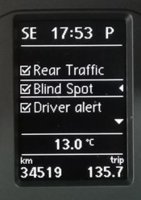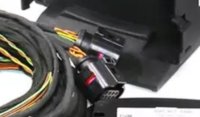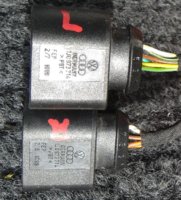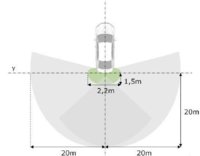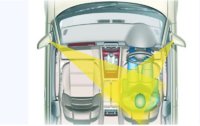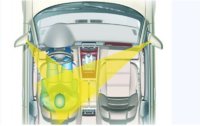I think I have managed to provoke you to show off mateWouldn't it be easier to install them externally - would work also for barn doors?
View attachment 65259
You are using an out of date browser. It may not display this or other websites correctly.
You should upgrade or use an alternative browser.
You should upgrade or use an alternative browser.
(Side Assist) / (Blind Spot Detection & Rear Cross Traffic Alert) retrofit
- Thread starter Robert
- Start date
These 5Q0 radars perform auto calibration so any position imperfections are going to be compensated by the software anywaysRober that looks great.
How did you find the right position ?
And can you share a drawing which shows where to drill a hole ...
And the length of the Three thingees
 .
.I only drilled one 3mm hole and another 4mm one as per the photo below

Then used RS Components plastic spacers, example below.
TNSPG-M3-8-10-I/S | TNSPG-M3-8-10-I/S, 10mm High Nylon Spacers With 8mm Diameter for M3 Screw | RS Components



I have managed to preform 35km long trip on a motorway today.
(I have a letter stating that I am an essential worker . Please don't ask for posting it here as I won't be showing off
. Please don't ask for posting it here as I won't be showing off  .)
.)
My 5Q0 SIDE ASSIST(BLIND SPOT) aspect of the system already works 100%.
Actually it works practically the same way as 7E0 system.
The only difference is the following:
- system start up(mirror LEDs glow up very slowly and gradually and start delay is much shorter comparing to 7E0 system)
and start delay is much shorter comparing to 7E0 system)
- extra menu in IC(Assist systems) for mirror LED brightness doesn't exits with 5Q0 units (credit to @mmi for cross checking this with MQB platform vehicles ). This adjustment on my old 7E0 system was useless anyway as I always kept it at max brightness and all other settings were too dark in my opinion.
). This adjustment on my old 7E0 system was useless anyway as I always kept it at max brightness and all other settings were too dark in my opinion.
Edit:
Obviously both 7E0 & 5Q0 systems adjust mirror LEDs brightness automatically via RLS sensor.
(I have a letter stating that I am an essential worker
My 5Q0 SIDE ASSIST(BLIND SPOT) aspect of the system already works 100%.
Actually it works practically the same way as 7E0 system.
The only difference is the following:
- system start up(mirror LEDs glow up very slowly and gradually
- extra menu in IC(Assist systems) for mirror LED brightness doesn't exits with 5Q0 units (credit to @mmi for cross checking this with MQB platform vehicles
 ). This adjustment on my old 7E0 system was useless anyway as I always kept it at max brightness and all other settings were too dark in my opinion.
). This adjustment on my old 7E0 system was useless anyway as I always kept it at max brightness and all other settings were too dark in my opinion.Edit:
Obviously both 7E0 & 5Q0 systems adjust mirror LEDs brightness automatically via RLS sensor.
Now it is time for OEM T6 mirror LEDs adaptation to 5Q0 radars.
Initially I have thought about adding simple power resistors. I have done my mathematical calculations and came up with 46.5 ohms. Then realised that I could use some (less or more sophisticated) voltage converters instead. Unfortunately this was not the right way and the reasons are listed below.
1. Supplying voltage to mirror LEDs must be converted in such way so it replicates original system behaviour. This means slow and gradual glow up when system is activated or ignition is switched ON. Also fast full brightness flash if indicator is switched ON while there is an overtaking vehicle in the detection zone. Slow glow up is not done by simply increasing DC voltage from 0V to 12(14.4)V but instead it is done by pulse width modulation (PWM). This complicates voltage converter selection a little bit.
2. 5Q0 radars constantly monitor current sent out to the LEDs (when they are activated) and also periodically checks their impedance (resistance). This built in fault detection feature causes problems with most converters that I have tried and results with abnormality detection and system fault. Simply saying input impedance of voltage converter is out of the expected range.
All of the above turned me back to my original idea. I have experimented with adjustable precision potentiometer and worked out that 200 ohms gives the best results(voltage and brightness wise) and no faults in the system. Below is the video of the voltage measured directly on the LHS OEM T6 LED with the power resistor of 200 ohms in series. The RHS output is connected to OEM Golf LED just for comparison. Just to see any voltage at all the system was obviously constantly switched ON and OFF in the IC menu.
Initially I have thought about adding simple power resistors. I have done my mathematical calculations and came up with 46.5 ohms. Then realised that I could use some (less or more sophisticated) voltage converters instead. Unfortunately this was not the right way and the reasons are listed below.
1. Supplying voltage to mirror LEDs must be converted in such way so it replicates original system behaviour. This means slow and gradual glow up when system is activated or ignition is switched ON. Also fast full brightness flash if indicator is switched ON while there is an overtaking vehicle in the detection zone. Slow glow up is not done by simply increasing DC voltage from 0V to 12(14.4)V but instead it is done by pulse width modulation (PWM). This complicates voltage converter selection a little bit.
2. 5Q0 radars constantly monitor current sent out to the LEDs (when they are activated) and also periodically checks their impedance (resistance). This built in fault detection feature causes problems with most converters that I have tried and results with abnormality detection and system fault. Simply saying input impedance of voltage converter is out of the expected range.
All of the above turned me back to my original idea. I have experimented with adjustable precision potentiometer and worked out that 200 ohms gives the best results(voltage and brightness wise) and no faults in the system. Below is the video of the voltage measured directly on the LHS OEM T6 LED with the power resistor of 200 ohms in series. The RHS output is connected to OEM Golf LED just for comparison. Just to see any voltage at all the system was obviously constantly switched ON and OFF in the IC menu.
Also there are total of 12 connectors N10335706 in these 2 plugs 1J0973714@Robert: can you please tell uns the VW Part-Numbers of the Plugs for the LED Modul and for the 5Q0 Modules?
Thank you!
 .
.There you goThank you @Robert !
I think I have the OEM Number for the LED Plug. I will post it later after testing.
Do you habe the Pinout from the 5Q0-sensors?
Master J1086 right - connector T8bs
3 - CAN high to pin 19 on BCM plug B (white)
4 - CAN low to pin 18 on BCM plug B (white)
5 - GND
6 - to Slave 6
7 - to Slave 7
8 - +12V, terminal 15a
Slave J1087 left - connector T8br
3 - lamp mirror right K304
4 - lamp mirror left K303
5 - GND
6 - from Master 6
7 - from Master 7
8 - +12V, terminal 15a
And again credit to @mmi for his involvement
Actually there are 3 pins on each OEM mirror LED. Middle one is not in use.Thank you @Robert !
Can you please tell me a small thing more
Slave J1087 left - connector T8br
3 - lamp mirror right K304 to LED Pin 1 or 2?
4 - lamp mirror left K303 to LED Pin 1 or 2?
The second LED Pin goes to Ground?
GND is common for both sides and then you have to try it yourself.
These LEDs are polarity sensitive, they will only work if supply is connected correctly.









